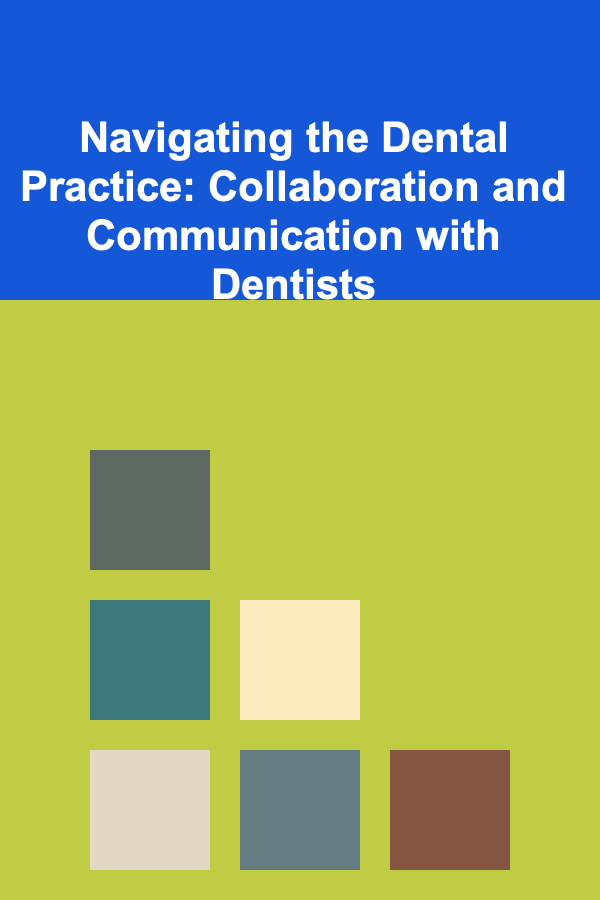
Navigating the Dental Practice: Collaboration and Communication with Dentists
ebook include PDF & Audio bundle (Micro Guide)
$12.99$11.99
Limited Time Offer! Order within the next:

In a dental practice, effective collaboration and communication between dental hygienists and dentists are paramount for delivering optimal patient care. Both professionals play essential roles in ensuring that patients receive comprehensive, effective, and compassionate treatment. However, each brings a unique set of skills, knowledge, and responsibilities to the table. Navigating the relationship between these two roles is critical for creating a harmonious work environment and ensuring the highest standard of care. This article will explore practical strategies, techniques, and tips to enhance collaboration and communication between dental hygienists and dentists.
The Importance of a Collaborative Approach
The success of a dental practice is often determined by how well the team works together. Dentists and hygienists must function as a cohesive unit, not only in the treatment room but also in discussions about patient care, treatment plans, and office management. When collaboration is prioritized, patients experience smoother, more efficient care, and the overall quality of treatment improves. Moreover, a positive working relationship between hygienists and dentists fosters a more pleasant work atmosphere, where mutual respect and understanding thrive.
Enhanced Patient Outcomes
When dentists and hygienists communicate effectively, they can address a patient's needs more comprehensively. Regular updates and open lines of communication allow both parties to collaborate on the diagnosis, treatment planning, and follow-up care. Patients benefit from this cohesive approach, experiencing fewer gaps in care and a more holistic treatment experience.
Greater Efficiency and Productivity
Clear communication helps streamline patient flow and reduces inefficiencies. When everyone in the practice is on the same page, the team can tackle tasks more effectively, leading to a more productive workday and better utilization of time and resources. This efficiency also minimizes delays, ensuring that patients are treated promptly and with attention to detail.
Key Strategies for Improving Collaboration and Communication
Effective communication is a skill that requires ongoing effort and practice. Below are actionable strategies for dental hygienists and dentists to improve collaboration and create a more productive work environment.
1. Establishing Clear Roles and Expectations
One of the most common sources of tension in a dental practice arises when team members are unclear about their roles and responsibilities. This ambiguity can lead to confusion, missed steps, and miscommunication. Setting clear roles from the start and discussing expectations regularly can help mitigate these issues.
- Actionable Tip: Before each treatment or procedure, both the hygienist and dentist should clarify their roles. The dentist should review the patient's treatment plan and outline what they expect from the hygienist, while the hygienist should express any concerns or observations that may affect the patient's care.
- Actionable Tip: Regularly meet as a team to discuss changes in protocols, patient care approaches, and any new tools or technology. This ensures that everyone understands how their roles fit into the larger picture and fosters a collaborative mindset.
2. Frequent and Consistent Communication
Constant communication is the bedrock of successful teamwork. Regularly updating each other on patient progress, discussing concerns, and checking in about treatment plans ensures that both the hygienist and dentist are in sync.
- Actionable Tip: During patient treatment, the hygienist should continuously communicate with the dentist, particularly if there are any changes in the patient's condition, or if there is an observed complication or concern. This allows the dentist to adjust treatment accordingly and ensures that the team is aligned throughout the procedure.
- Actionable Tip: Use the dental software or charting systems to document patient notes and treatment plans that can be easily accessed by both the hygienist and dentist. These platforms offer a secure and centralized location for ongoing communication regarding patient care.
3. Mutual Respect for Expertise
Dentists and hygienists have different skill sets, but both are integral to patient care. Dentists are typically focused on diagnosis, treatment planning, and complex procedures, while hygienists concentrate on preventive care, education, and the maintenance of oral health. Acknowledging and respecting each other's expertise is crucial for fostering a collaborative environment.
- Actionable Tip: Take time to recognize the strengths and contributions of each other. For example, dentists should acknowledge the hygienist's role in educating patients about oral hygiene, while hygienists can appreciate the dentist's diagnostic skills and ability to perform complex procedures.
- Actionable Tip: When a dentist or hygienist makes a suggestion, try to listen without immediately countering. This not only shows respect but also fosters an environment where everyone feels heard and valued, leading to more effective collaboration.
4. Engage in Joint Problem-Solving
When challenges arise, such as complex patient needs, difficult diagnoses, or treatment plan disagreements, it is essential for both the dentist and hygienist to engage in joint problem-solving. Addressing challenges collaboratively improves patient care and ensures that all options are considered before making critical decisions.
- Actionable Tip: When faced with a challenging situation, like a patient exhibiting anxiety or refusal of treatment, engage in a team discussion to come up with potential solutions. For example, the hygienist may have suggestions for how to calm the patient, while the dentist might recommend a different approach to treatment.
- Actionable Tip: When new treatment protocols or technologies are introduced, discuss them together. Collaboration in learning new systems or tools ensures that both the dentist and hygienist are equipped to use them effectively, making the practice more efficient.
5. Regular Feedback and Open Dialogue
Constructive feedback and open dialogue are critical components of continuous improvement in a dental practice. Providing feedback in a non-judgmental and supportive manner helps both the dentist and hygienist refine their techniques and improve patient care.
- Actionable Tip: After a patient is seen, take time to discuss how the procedure went. Did the treatment plan work? Were there any challenges or missed opportunities for improvement? Use this discussion as a chance to offer each other feedback that will help refine practice standards.
- Actionable Tip: Encourage a culture of open dialogue where both the hygienist and dentist feel comfortable discussing challenges or uncertainties. If something doesn't go as planned, it's important to have a solution-oriented mindset rather than assigning blame.
6. Cultivate Empathy and Understanding
Empathy is essential in healthcare, not just for patients but also between colleagues. Recognizing the pressures each team member faces and understanding their individual challenges can go a long way in improving collaboration.
- Actionable Tip: Be empathetic to the pressures that dentists face when managing multiple complex procedures, and be understanding when hygienists face challenges with patient communication or preventive care. By acknowledging each other's struggles, team members can offer support when needed.
- Actionable Tip: Show appreciation for each other's work, both publicly and privately. Simple gestures like expressing gratitude or acknowledging someone's contributions can help boost morale and create a positive working environment.
7. Effective Use of Technology
In today's modern dental practice, technology plays a huge role in enhancing communication and collaboration. From electronic health records (EHR) to digital imaging, utilizing these tools can streamline the workflow and improve communication between the dentist and hygienist.
- Actionable Tip: Ensure both the dentist and hygienist are proficient with the practice's digital systems. Whether it's reviewing patient charts, updating treatment notes, or checking X-ray images, ensuring that both parties have access to accurate, real-time data will improve the efficiency and accuracy of care.
- Actionable Tip: Invest in communication platforms that facilitate team collaboration. Software tools that allow for instant messaging or the sharing of patient notes can drastically reduce misunderstandings and streamline workflows.
Creating a Culture of Teamwork
Beyond the immediate communication strategies and tools, fostering a broader culture of teamwork in the dental office is essential for long-term success. A practice that prioritizes collaboration creates a supportive environment where both the dentist and hygienist can perform at their best.
- Actionable Tip: Encourage social interactions among team members outside of patient care. Organizing team-building activities or social events fosters trust and camaraderie, which ultimately improves communication and cooperation in the workplace.
- Actionable Tip: Promote a shared vision for patient care and office goals. When everyone in the practice is working toward the same objective, whether it's improving patient satisfaction or expanding services, collaboration becomes second nature.
Conclusion
Collaboration and communication between dentists and hygienists are essential for providing exceptional care, improving patient outcomes, and fostering a positive work environment. By implementing strategies such as setting clear expectations, maintaining frequent and open communication, respecting each other's expertise, and leveraging technology, dental teams can work more effectively together. A culture of teamwork ensures not only a more efficient dental practice but also a more fulfilling and rewarding experience for both the staff and patients. Ultimately, when both the dentist and hygienist are aligned in their approach, patients receive the best possible care, and the practice flourishes.

Budget-Friendly DIY Holiday Decorations and Crafts for a Festive Touch
Read More
How to Create a Home Office with Efficient Storage Options
Read More
How to Incorporate Labels for Easy Identification of Craft Items
Read More
How to Make a Checklist for Evacuating Your Home in an Emergency
Read More
How to Use Hooks and Pegboards for Toy Storage
Read More
What Should You Consider When Creating a Cozy Reading Nook?
Read MoreOther Products

Budget-Friendly DIY Holiday Decorations and Crafts for a Festive Touch
Read More
How to Create a Home Office with Efficient Storage Options
Read More
How to Incorporate Labels for Easy Identification of Craft Items
Read More
How to Make a Checklist for Evacuating Your Home in an Emergency
Read More
How to Use Hooks and Pegboards for Toy Storage
Read More